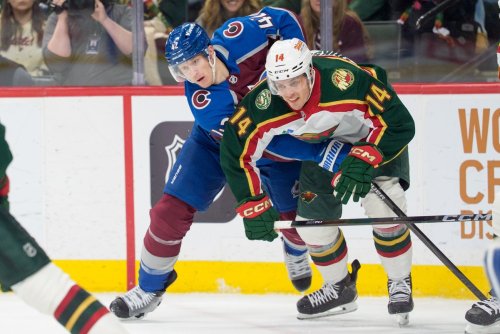
We didn’t appreciate Declan Chisholm’s arrival enough.
When the Wild claimed the 24-year-old left-shot defenseman, it quietly made the news. Minnesota’s third pair has been a liability all season, and Chisholm has only played four NHL games. At first glance, it looked like this waiver claim might be a long shot.
But after turning on the tape, Chisholm’s tools seem to fit exactly what Minnesota needs on the third pair.
A few skills make up the strongest parts of Chisholm’s game: quick hands, a hard shot, and a knack for carrying the puck. His hands are evident in the offensive and defensive zones, and he uses his skating stride to carry the puck in transition.
Chisholm’s abilities put him in place to contribute to the team’s 5-on-5 offense and on the power play in some of the ways that Calen Addison should have. Chisholm likely won’t quarterback the man advantage like Addison because he’s not as agile. But his ability to create fast, simple puck movement should earn him a defined role.
Chisholm’s breakout and transition skills are different from Addison’s. Addison was great at seeing and completing long passes from deep in the defensive zone to the other side of the ice. Chisholm doesn’t make those home-run passes, but his deft stickhandling serves him well in tight corners and against the opposing forecheck.
The messy-looking breakout play above is standard in the NHL. It’s been a Wild staple under John Hynes, and even before his arrival. Jack Han scouted this out and diagramed it in Hockey Tactics 2023. Hynes ran the same breakout last year in Nashville.

Note how both of Chisholm’s passes draw an opponent deep into his own defensive zone. First, along the left faceoff circle, then below the goal line on the goaltender’s right. That opens space deeper down the ice for the forwards to get open.
The breakout above isn’t a perfect example of the shape Hynes wants to create on the breakout. Chisholm’s partner is spread out behind the net rather than pushing through the center of the defensive zone. But that’s not terribly important because it still demonstrates the value of Chisholm’s quick hands along the boards.
However, it’s important to note Hynes’s preferred structure because it fits Chisholm’s straight-line speed. Looking at the weakside defenseman (D2 in the above diagram), you can see how that speed will serve him well in this system. If his partner breaks the puck up the wall, Chisholm is free to join the rush if the opportunity is right.
When executed correctly, the neutral zone looks something like this:

Chisholm (D2 in this scenario) is a great fit to catch and skate a change-of-side pass. D2’s first priority is gaining the zone onsides and then establishing the cycle. Chisholm has done this before in the OHL:
Surely, Chisholm won’t have quite as much space in the NHL as he does in the clip above, but it demonstrates how his speed allows him to gain the zone, even when outnumbered. This skill can establish easier forechecking or extended zone possessions for the forwards. That will serve him well when he’s feeding shooters like Kaprizov and Boldy.
When Chisholm isn’t the puck carrier, he’s still a great support player off the rush. He sees opportunities to join the rush early, which leads to odd-man rush opportunities. Chisholm also has the skills to finish when he’s called upon.
All of this is highly encouraging. It may lead the Ontario native to be a better 5-on-5 contributor than Addison was in Minnesota. Chisholm still has some of the defensive warts that come with the “offensive defenseman” label, but his skills in the rush may be a better fit than Addison’s possessive play style. On top of that, the 6-foot-1, 190 lbs. defenseman is built a bit sturdier than Addison (5-foot-11, 173 lbs.), which should allow him to box out the front of the net at the level of most third-pair defensemen.
Addison holds one trump card over Chisholm, which is his ability to “quarterback” a power play. While Chisholm’s profile makes him a better option from the top of the circles, Addison’s quick feet allow him to direct traffic from center ice because of his agile, powerful footwork. That will enable him to manipulate shooting and passing lanes in a way that Chisholm can’t.
The right-handed power play quarterback is a sought-after role in the NHL because few players have the vision and edgework to execute that role. However, Chisholm is useful in another power-play role. His heavy slapshot and knack for handling the puck make him useful from the perimeter.

Like No. 86 on the Tampa Bay Lightning above, Chisholm can set up from the top of either circle for a one-timer, and a passing option to relieve pressure. He's no Nikita Kucherov, but his skill set fits that role because Chisholm won't be the focal point of the power play.
The reason that Chisholm can play here is not just his heavy shot but his ability to catch-and-pass. It’s better to have quick hands and skates like Addison does, but the ability to catch a puck and pass it immediately is crucial to take advantage of the extra skater. It’s what led to Chisholm’s first NHL point:
Chisholm’s quick hands are the key to breaking down an opponent’s defensive structure through puck movement or set plays. An example of Chisholm running a set play on the OHL’s Peterborough Pirates shows how indefensible this can be.
The teams are playing five-on-five in the clip above, but it highlights how Chisholm’s quick hands can punish shot-block attempts from over-aggressive defenders. That becomes especially potent when combined with Chisholm’s clap bomb, a weapon of mass production. He unleashed it to score his first AHL goal in Manitoba.
The slapshot goals are all over Chisholm’s highlight reel, and Wild fans are familiar with the ways that can open up the power play. Matt Dumba and Brad Hunt had a certain gravity on the power play, and Chisholm should experience the same. When defenders don’t square up to the shooting lane, there are consequences.
Minnesota-born Chaz Lucius won’t notch an easier assist in his whole career. Chisholm can turn a low-to-high pass into something goaltenders simply can’t see.
It will take some time for Chisholm’s game to mature fully. There must be reasons he hasn't earned more than 49 minutes of NHL ice time by age 24. But his offensive tools are effective enough that it likely stems from Winnipeg’s depth.
Chisholm seems primed to contribute as a third-pairing power-play defenseman for less than a one-million-dollar AAV over the next few years. That’s a great asset, especially since the Wild acquired him for free. It’s as much value as a team can get off waivers.
When Chisholm hits the ice, it will be long overdue.
Think you could write a story like this? Hockey Wilderness wants you to develop your voice, find an audience, and we'll pay you to do it. Just fill out this form.
-
 3
3







Recommended Comments
Join the conversation
You can post now and register later. If you have an account, sign in now to post with your account.
Note: Your post will require moderator approval before it will be visible.